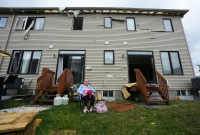Support strong Canadian climate journalism for 2025
On Thursday and Friday, Neskantaga First Nation will face off in court against the Ontario government over what the nation argues was a flawed consultation on a road that will link the province’s road infrastructure with the Ring of Fire mining region.
Neskantaga First Nation, a remote, fly-in community located over 400 kilometres north of Thunder Bay, maintains the provincial government’s consultation process for the project’s environmental assessment was inadequate.
The nation also claims the assessment on the road would set a precedent and cause “significant consequences” for future projects in the region, like the proposed Eagle’s Nest Mine, court documents obtained by Canada’s National Observer show.
“Given those failings, the [Neskantaga First Nation] brings this application amidst serious concerns that Ontario’s current process falls well below what is legally required,” the documents said.
There is concern that Indigenous rights and title to the land and harvests would be impacted by pollution, including harm to the Attawapiskat River, where the First Nation and its ancestral territory sits.
“Justice demands a meaningful process, and we have shown we are willing to go to the courts to get it,” former chief Wayne Moonias said in a press release.
Neskantaga First Nation filed the court challenge in 2021 when the community dealt with multiple crises, including the pandemic and a 26-year-long boil water advisory, the longest in Canada. The crises consumed the energy of the nation’s leaders, making it impossible for them to give their full attention to the assessment process.
For example, there were community evacuations caused by water safety concerns while the environmental assessment for one part of the road took place, according to court documents.
The pandemic, which prompted the community to close its border three times, also disrupted travel and reduced the in-person meetings needed for the province to fulfil meaningful consultation, Neskantaga argues.
“It is stunning in this day and age that a law intended to apply to mining and exploration in Indigenous homelands is utterly lacking in a framework for meaningful consultations,” Julian Falconer, of Neskantaga’s legal team, said in a press release.
“We are going to court to create some ground rules around consultations with Indigenous Peoples, starting at the earliest stages of an environmental assessment and the drafting of terms of reference,” he added.
As the matter remains before the courts, it would be inappropriate for the Ministry of Mines to comment on the case, the provincial government said in a statement to Canada's National Observer.
Matteo Cimellaro / Canada’s National Observer / Local Journalism Initiative
This article has been updated to reflect comments from the provincial government.







Comments
Chief Moonias is one of my real heroes . The Breathing Lands, Yehwin Aski in Cree, are their traditional territories to STEWARD low these past 8000 years and counting.
see Wilkinson’s pushback in yesterday’s To. Star on the need to respect FN Sovereignty and Peatlands sequestering capacity , ( not to mention the lowland’s undammed waterway to the arctic) and find minerals in less disruptive, closer to production locations also in Ontario. the good news imo is his willingness to consult and apply environmental damage assessments ( which should put paid to mining development)
.First Nations dignity, clarity of purpose and spirit are admirable and make me deeply ashamed of our cringe -nducing provincial government ‘s ignorance, greed and cruelty.
Oh, come on. That doesn't really MAKE you ashamed of the Ontario provincial government; I'm certain we could all be ashamed of them even without that contrast! :D